Operations Process Resources - Execute
-
ATP 6-0.5: Command Post Organization & Operations - ATP 6-0.5 expands on command post (CP) tactics and procedures found in FM 6-0. This publication provides considerations for organizing a headquarters into CPs and techniques for employing and conducting CP operations. The material in this publication provides a framework for units to develop and refine their standard operating procedures (SOPs) for CP operations. Example, Battle Rhythm & Meeting; and Command Post Battle Drills.
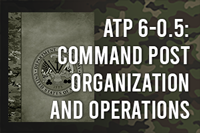
-
TC 6-0 Series - TC 6-0 is an introductory guide for commanders at battalion through corps levels to use during unit training management and planning. The publication provides the background information for commanders, leaders, and Soldiers who plan, prepare, execute, and assess training of mission command at battalion, brigade, division, corps, and joint levels.
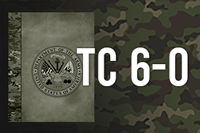
-
Mission Command Information System Training Resources - Provides information about the Army’s approach to training the mission command warfighting function and highlights several training considerations and enablers that, when implemented, will improve unit readiness. Note: Access requires CAC credentials.
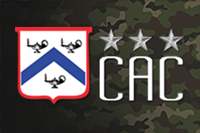
-
150-C2-5315: Establish the Common Operational Picture - The staff officer establishes the common operational picture to provide the commander a single display of relevant information within an area of interest tailored to the unit's requirements and based on common data and information shared by more than one command to develop knowledge and shared understanding in accordance with ADP 6-0, the commander's intent, orders from higher headquarters, and standard operating procedures.
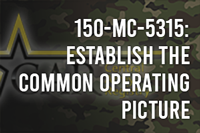
-
Command Post Computing Environment and Command Post of the Future Integration Handbook - The Command Post Computing Environment (CPCE) and Command Post of the Future (CPOF) Integration Handbook is focused on the integration of command and control information systems (C2IS) at the brigade (BDE) and battalion level. This handbook also provides information for the most common C2IS found at all echelons. This handbook provides instructions about how to display command and control (C2) information on the CPCE and CPOF workstations. Note: Access requires CAC credentials.
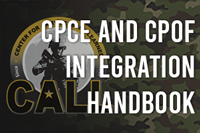 For more lessons learned and up-to-date content, visit the restricted CALL SharePoint site. Note: Access requires CAC credentials and site registration by CALL team.
For more lessons learned and up-to-date content, visit the restricted CALL SharePoint site. Note: Access requires CAC credentials and site registration by CALL team. -
Sustainment Battle Rhythms - A headquarters battle rhythm consists of a series of meetings (to include those conducted by boards, working groups, and planning teams), reports, and other activities synchronized by time and purpose (ATP 6-0.5, App A). Note: Access requires CAC credentials.
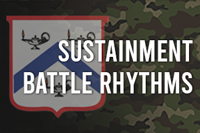
-
Battle Rhythms: Challenges, Considerations, and Recommendations from Warfighter Exercises - In this article, CALL’s liaison to MCTP outlines ways to help units develop, refine, and implement a sustainable battle rhythm during operations.
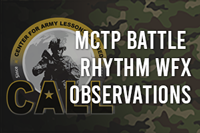 For more lessons learned and up-to-date content, visit the restricted CALL SharePoint site. Note: Access requires CAC credentials and site registration by CALL team.
For more lessons learned and up-to-date content, visit the restricted CALL SharePoint site. Note: Access requires CAC credentials and site registration by CALL team. -
Battle Rhythm: The Sustainment Bde Staff's Critical Path - Knowing your unit's critical path is the key to success. The SB HQs critical path has four meetings that include working groups (WG) and boards. They include the support operations (SPO) logistics synchronization working group (LOG SYNCH), the SPO movement board, the SPO distribution management board (DMB), and finally the S3's (operations officer) operations synchronization board (OPS SYNCH).
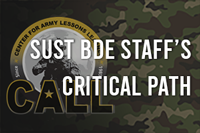 For more lessons learned and up-to-date content, visit the restricted CALL SharePoint site. Note: Access requires CAC credentials and site registration by CALL team.
For more lessons learned and up-to-date content, visit the restricted CALL SharePoint site. Note: Access requires CAC credentials and site registration by CALL team. -
150-DMG-2016: Present Command Post Update Briefing - Present Command Post Update Briefing, 150-DMG-2016: Present the update briefing to the Command Team per unit, digital, and/or knowledge management SOP and this task. Note: Access requires CAC credentials.
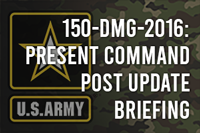
-
FM 6-99: U.S. Army Report & Message Formats - The U.S. Army’s doctrinal library for report and message voice templates. It prevents units from wasting time and resources developing internal formats. FM 6-99 formats are derived from Army Battle Command Systems (ABCS); United States message text formats (USMTF), historical Army reports, and Allied Procedures Publications (APP).
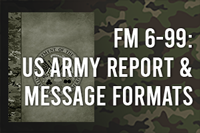
-
10-42: Operations Officer Handbook - Key concepts addressed in this handbook include: Management and effective dissemination of information (battle tracking, battle update briefings, commander's updates, and daily fragmentary orders); Command post organization and operation; Training management; Battle drills; Targeting; Leader development. Note: Access requires CAC credentials.
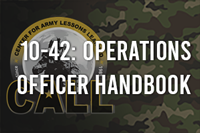 For more lessons learned and up-to-date content, visit the restricted CALL SharePoint site. Note: Access requires CAC credentials and site registration by CALL team.
For more lessons learned and up-to-date content, visit the restricted CALL SharePoint site. Note: Access requires CAC credentials and site registration by CALL team. -
The Science of Control: Synchronizing Current Operations Cells (CALL News from the Front) - The current operations (CUOPS) cell is essential to translating plans to orders and eventually to the execution of combat operations. The CUOPS integrating cell is critical in synchronizing operations, sustaining the common operational picture and mitigating risk to the mission. In the operations process, the CUOPS cell is the commander's most prominent tool to understand, describe, visualize, and direct operations.
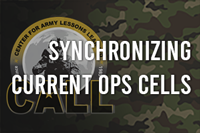 For more lessons learned and up-to-date content, visit the restricted CALL SharePoint site. Note: Access requires CAC credentials and site registration by CALL team.
For more lessons learned and up-to-date content, visit the restricted CALL SharePoint site. Note: Access requires CAC credentials and site registration by CALL team. -
20-550: Knowledge Management Case Studies, Volume II - Knowledge management (KM) remains an important integrating process required of all staff officers. Commanders and staffs employ KM techniques to create, organize, apply, and transfer data and information to accelerate its transformation into knowledge and support effective decision-making. Note: Access requires CAC credentials.
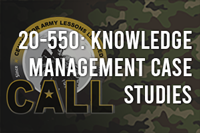 For more lessons learned and up-to-date content, visit the restricted CALL SharePoint site. Note: Access requires CAC credentials and site registration by CALL team.
For more lessons learned and up-to-date content, visit the restricted CALL SharePoint site. Note: Access requires CAC credentials and site registration by CALL team.

